stop start FIAT 500L 2019 Owner handbook (in English)
[x] Cancel search | Manufacturer: FIAT, Model Year: 2019, Model line: 500L, Model: FIAT 500L 2019Pages: 248, PDF Size: 5.74 MB
Page 52 of 248
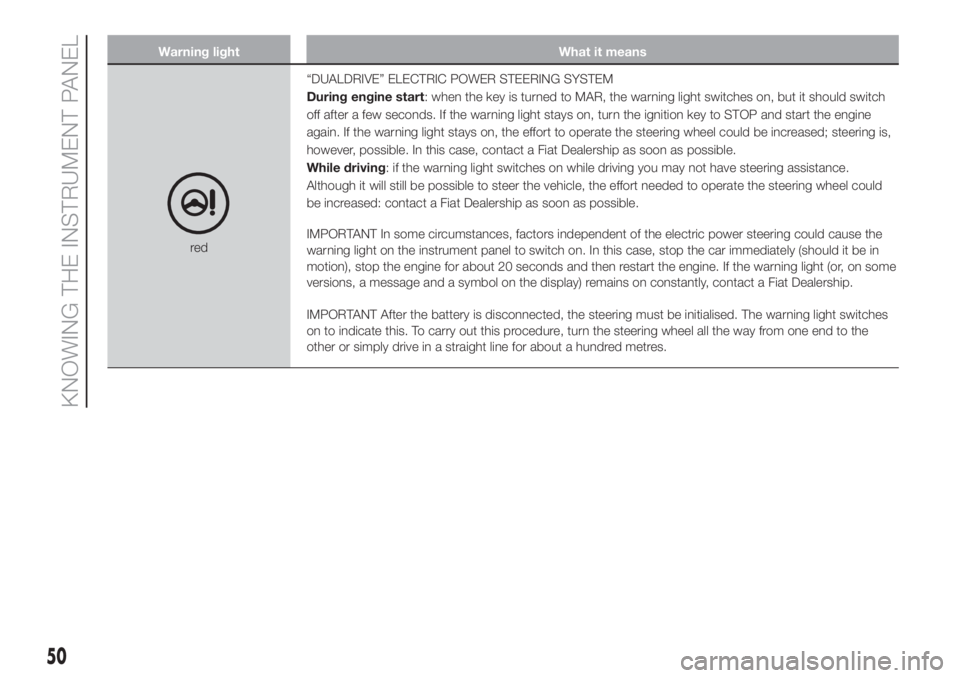
Warning light What it means
red“DUALDRIVE” ELECTRIC POWER STEERING SYSTEM
During engine start: when the key is turned to MAR, the warning light switches on, but it should switch
off after a few seconds. If the warning light stays on, turn the ignition key to STOP and start the engine
again. If the warning light stays on, the effort to operate the steering wheel could be increased; steering is,
however, possible. In this case, contact a Fiat Dealership as soon as possible.
While driving: if the warning light switches on while driving you may not have steering assistance.
Although it will still be possible to steer the vehicle, the effort needed to operate the steering wheel could
be increased: contact a Fiat Dealership as soon as possible.
IMPORTANT In some circumstances, factors independent of the electric power steering could cause the
warning light on the instrument panel to switch on. In this case, stop the car immediately (should it be in
motion), stop the engine for about 20 seconds and then restart the engine. If the warning light (or, on some
versions, a message and a symbol on the display) remains on constantly, contact a Fiat Dealership.
IMPORTANT After the battery is disconnected, the steering must be initialised. The warning light switches
on to indicate this. To carry out this procedure, turn the steering wheel all the way from one end to the
other or simply drive in a straight line for about a hundred metres.
50
KNOWING THE INSTRUMENT PANEL
Page 56 of 248
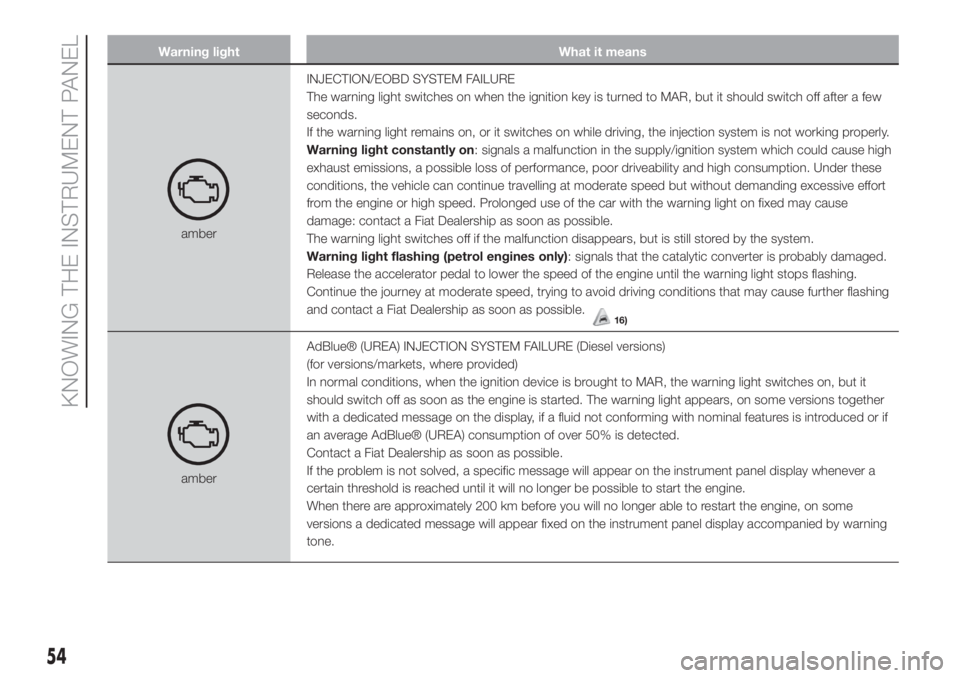
Warning light What it means
amberINJECTION/EOBD SYSTEM FAILURE
The warning light switches on when the ignition key is turned to MAR, but it should switch off after a few
seconds.
If the warning light remains on, or it switches on while driving, the injection system is not working properly.
Warning light constantly on: signals a malfunction in the supply/ignition system which could cause high
exhaust emissions, a possible loss of performance, poor driveability and high consumption. Under these
conditions, the vehicle can continue travelling at moderate speed but without demanding excessive effort
from the engine or high speed. Prolonged use of the car with the warning light on fixed may cause
damage: contact a Fiat Dealership as soon as possible.
The warning light switches off if the malfunction disappears, but is still stored by the system.
Warning light flashing (petrol engines only): signals that the catalytic converter is probably damaged.
Release the accelerator pedal to lower the speed of the engine until the warning light stops flashing.
Continue the journey at moderate speed, trying to avoid driving conditions that may cause further flashing
and contact a Fiat Dealership as soon as possible.
16)
amberAdBlue® (UREA) INJECTION SYSTEM FAILURE (Diesel versions)
(for versions/markets, where provided)
In normal conditions, when the ignition device is brought to MAR, the warning light switches on, but it
should switch off as soon as the engine is started. The warning light appears, on some versions together
with a dedicated message on the display, if a fluid not conforming with nominal features is introduced or if
an average AdBlue® (UREA) consumption of over 50% is detected.
Contact a Fiat Dealership as soon as possible.
If the problem is not solved, a specific message will appear on the instrument panel display whenever a
certain threshold is reached until it will no longer be possible to start the engine.
When there are approximately 200 km before you will no longer able to restart the engine, on some
versions a dedicated message will appear fixed on the instrument panel display accompanied by warning
tone.
54
KNOWING THE INSTRUMENT PANEL
Page 59 of 248
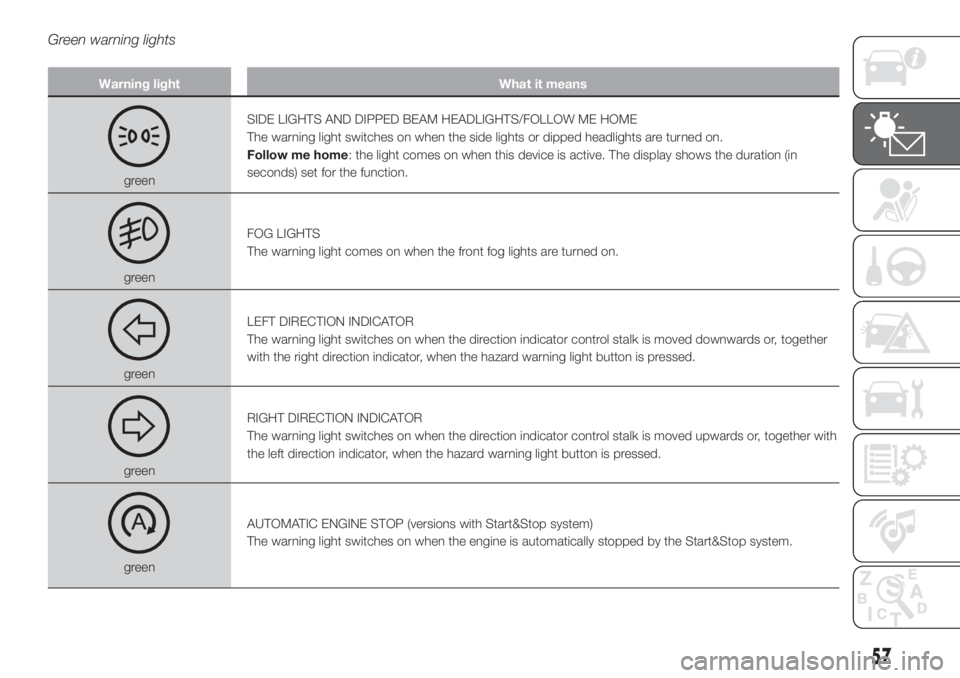
Green warning lights
Warning light What it means
greenSIDE LIGHTS AND DIPPED BEAM HEADLIGHTS/FOLLOW ME HOME
The warning light switches on when the side lights or dipped headlights are turned on.
Follow me home: the light comes on when this device is active. The display shows the duration (in
seconds) set for the function.
greenFOG LIGHTS
The warning light comes on when the front fog lights are turned on.
greenLEFT DIRECTION INDICATOR
The warning light switches on when the direction indicator control stalk is moved downwards or, together
with the right direction indicator, when the hazard warning light button is pressed.
greenRIGHT DIRECTION INDICATOR
The warning light switches on when the direction indicator control stalk is moved upwards or, together with
the left direction indicator, when the hazard warning light button is pressed.
greenAUTOMATIC ENGINE STOP (versions with Start&Stop system)
The warning light switches on when the engine is automatically stopped by the Start&Stop system.
57
Page 66 of 248
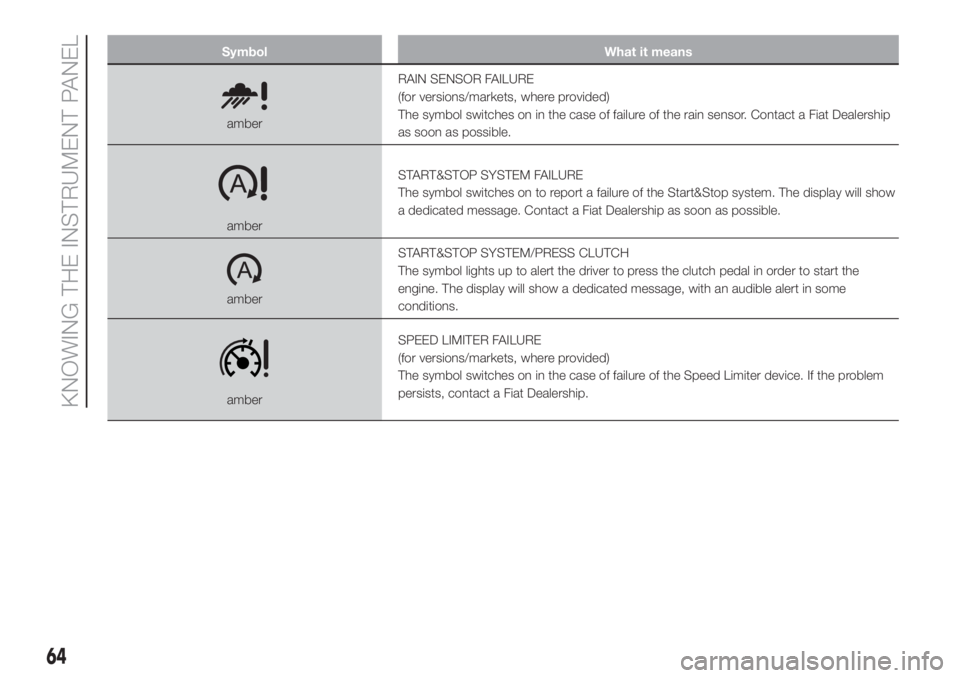
Symbol What it means
amberRAIN SENSOR FAILURE
(for versions/markets, where provided)
The symbol switches on in the case of failure of the rain sensor. Contact a Fiat Dealership
as soon as possible.
amberSTART&STOP SYSTEM FAILURE
The symbol switches on to report a failure of the Start&Stop system. The display will show
a dedicated message. Contact a Fiat Dealership as soon as possible.
amberSTART&STOP SYSTEM/PRESS CLUTCH
The symbol lights up to alert the driver to press the clutch pedal in order to start the
engine. The display will show a dedicated message, with an audible alert in some
conditions.
amberSPEED LIMITER FAILURE
(for versions/markets, where provided)
The symbol switches on in the case of failure of the Speed Limiter device. If the problem
persists, contact a Fiat Dealership.
64
KNOWING THE INSTRUMENT PANEL
Page 69 of 248
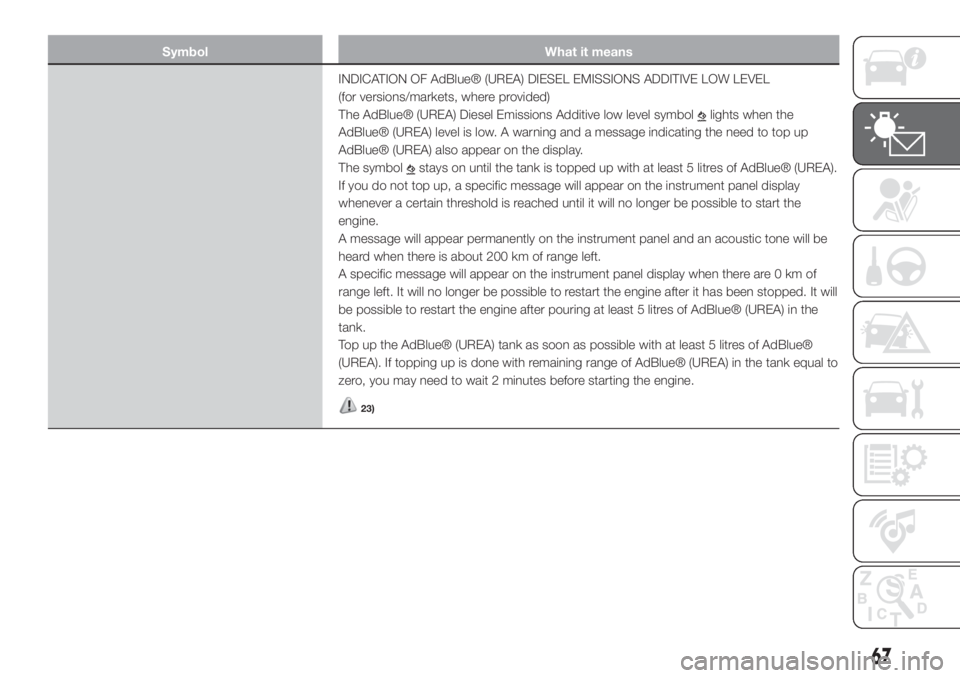
Symbol What it means
INDICATION OF AdBlue® (UREA) DIESEL EMISSIONS ADDITIVE LOW LEVEL
(for versions/markets, where provided)
The AdBlue® (UREA) Diesel Emissions Additive low level symbol
lights when the
AdBlue® (UREA) level is low. A warning and a message indicating the need to top up
AdBlue® (UREA) also appear on the display.
The symbol
stays on until the tank is topped up with at least 5 litres of AdBlue® (UREA).
If you do not top up, a specific message will appear on the instrument panel display
whenever a certain threshold is reached until it will no longer be possible to start the
engine.
A message will appear permanently on the instrument panel and an acoustic tone will be
heard when there is about 200 km of range left.
A specific message will appear on the instrument panel display when there are 0 km of
range left. It will no longer be possible to restart the engine after it has been stopped. It will
be possible to restart the engine after pouring at least 5 litres of AdBlue® (UREA) in the
tank.
Top up the AdBlue® (UREA) tank as soon as possible with at least 5 litres of AdBlue®
(UREA). If topping up is done with remaining range of AdBlue® (UREA) in the tank equal to
zero, you may need to wait 2 minutes before starting the engine.
23)
67
Page 70 of 248
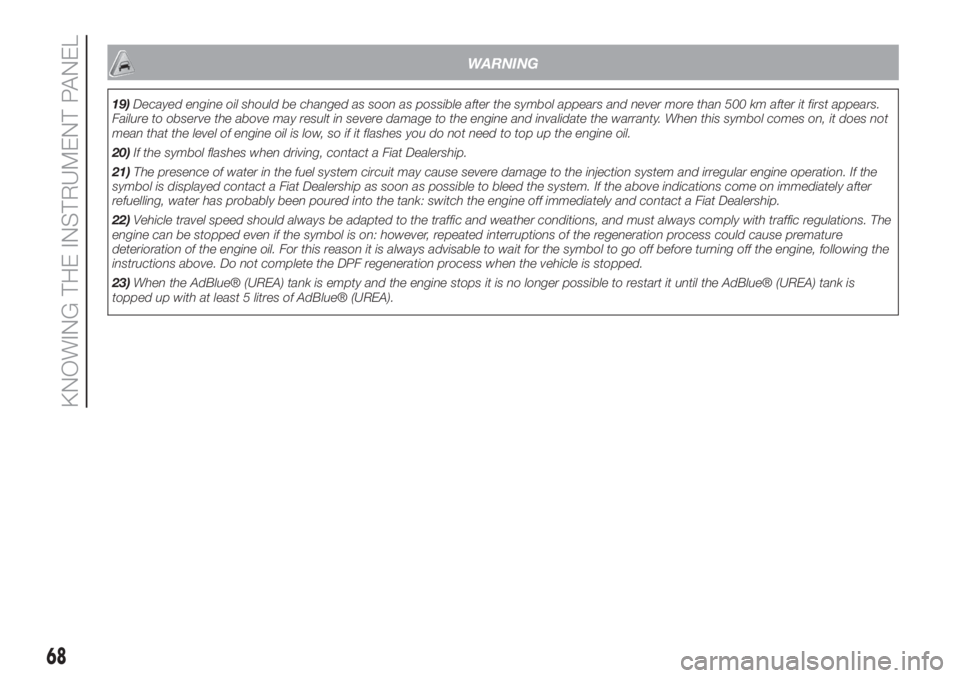
WARNING
19)Decayed engine oil should be changed as soon as possible after the symbol appears and never more than 500 km after it first appears.
Failure to observe the above may result in severe damage to the engine and invalidate the warranty. When this symbol comes on, it does not
mean that the level of engine oil is low, so if it flashes you do not need to top up the engine oil.
20)If the symbol flashes when driving, contact a Fiat Dealership.
21)The presence of water in the fuel system circuit may cause severe damage to the injection system and irregular engine operation. If the
symbol is displayed contact a Fiat Dealership as soon as possible to bleed the system. If the above indications come on immediately after
refuelling, water has probably been poured into the tank: switch the engine off immediately and contact a Fiat Dealership.
22)Vehicle travel speed should always be adapted to the traffic and weather conditions, and must always comply with traffic regulations. The
engine can be stopped even if the symbol is on: however, repeated interruptions of the regeneration process could cause premature
deterioration of the engine oil. For this reason it is always advisable to wait for the symbol to go off before turning off the engine, following the
instructions above. Do not complete the DPF regeneration process when the vehicle is stopped.
23)When the AdBlue® (UREA) tank is empty and the engine stops it is no longer possible to restart it until the AdBlue® (UREA) tank is
topped up with at least 5 litres of AdBlue® (UREA).
68
KNOWING THE INSTRUMENT PANEL
Page 73 of 248
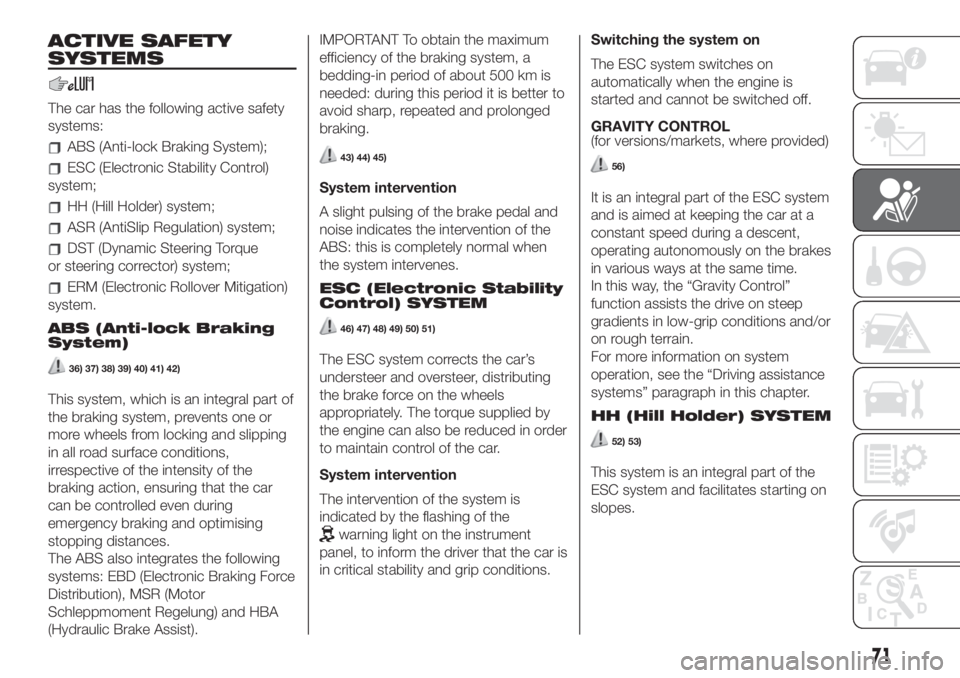
ACTIVE SAFETY
SYSTEMS
The car has the following active safety
systems:
ABS (Anti-lock Braking System);
ESC (Electronic Stability Control)
system;
HH (Hill Holder) system;
ASR (AntiSlip Regulation) system;
DST (Dynamic Steering Torque
or steering corrector) system;
ERM (Electronic Rollover Mitigation)
system.
ABS (Anti-lock Braking
System)
36) 37) 38) 39) 40) 41) 42)
This system, which is an integral part of
the braking system, prevents one or
more wheels from locking and slipping
in all road surface conditions,
irrespective of the intensity of the
braking action, ensuring that the car
can be controlled even during
emergency braking and optimising
stopping distances.
The ABS also integrates the following
systems: EBD (Electronic Braking Force
Distribution), MSR (Motor
Schleppmoment Regelung) and HBA
(Hydraulic Brake Assist).IMPORTANT To obtain the maximum
efficiency of the braking system, a
bedding-in period of about 500 km is
needed: during this period it is better to
avoid sharp, repeated and prolonged
braking.
43) 44) 45)
System intervention
A slight pulsing of the brake pedal and
noise indicates the intervention of the
ABS: this is completely normal when
the system intervenes.
ESC (Electronic Stability
Control) SYSTEM
46) 47) 48) 49) 50) 51)
The ESC system corrects the car’s
understeer and oversteer, distributing
the brake force on the wheels
appropriately. The torque supplied by
the engine can also be reduced in order
to maintain control of the car.
System intervention
The intervention of the system is
indicated by the flashing of the
warning light on the instrument
panel, to inform the driver that the car is
in critical stability and grip conditions.Switching the system on
The ESC system switches on
automatically when the engine is
started and cannot be switched off.
GRAVITY CONTROL
(for versions/markets, where provided)
56)
It is an integral part of the ESC system
and is aimed at keeping the car at a
constant speed during a descent,
operating autonomously on the brakes
in various ways at the same time.
In this way, the “Gravity Control”
function assists the drive on steep
gradients in low-grip conditions and/or
on rough terrain.
For more information on system
operation, see the “Driving assistance
systems” paragraph in this chapter.
HH (Hill Holder) SYSTEM
52) 53)
This system is an integral part of the
ESC system and facilitates starting on
slopes.
71
Page 76 of 248

DRIVING
ASSISTANCE
SYSTEMS
The car can feature the following driving
assistance systems:
City Brake Control - “Collision
Mitigation” system
iTPMS
For the operation of the systems, see
the following pages.
CITY BRAKE CONTROL -
“Collision Mitigation”
SYSTEM
(for versions/markets, where provided)
57) 58) 59) 60) 61)
24) 25) 26) 27) 28) 29) 30) 31)
This is a driving assistance system,
which includes a laser sensor, located
in the upper part of the windscreen
fig. 57, that can detect the presence of
nearby cars in front of the car.
In the event of an imminent collision the
system intervenes by automatically
braking to prevent the impact or
mitigate its effects.
The system is only active if:
the ignition key is turned to
MAR;
the car speed is between 5 and
30 km/h;
a forward gear is engaged;
the front seat belts are fastened;
the “Mode Selector” device is
in “Normal” mode.
Engagement/disengagement
The system can be deactivated (and
reactivated) using the display setup
menu (see the "Display" paragraph in
the "Knowing the instrument panel"
chapter).
Operation
The system intervenes if there is risk of
imminent collision and the driver does
not press the brake pedal promptly.
If the system detects that the vehicle
ahead could be hit, it may prepare the
vehicle to a possible emergency
braking.If the driver does not carry out any
action to prevent the collision, the
system may automatically slow down
the vehicle, in order to prepare it to
a possible impact.
When there is risk of impact, if the
action on the brake pedal by the driver
is not sufficient, the system may
intervene in order to improve
the reaction of the braking system,
therefore reducing vehicle speed
further.
When driving uphill on slopes with
major changes of gradient, the system
may intervene, activating the braking
system.
Versions equipped with Start&Stop
system: at the end of the automatic
braking, the Start&Stop system will
activate as described in the "Start&Stop
system" paragraph of the "Starting
and driving" chapter.
Versions equipped with manual
transmission: at the end of the
automatic braking, the engine may stall
and turn off, unless the clutch pedal
is pressed.
For versions with Dualogic
transmission: the last gear stored
remains engaged after braking.
57F0Y0200C
74
SAFETY
Page 77 of 248
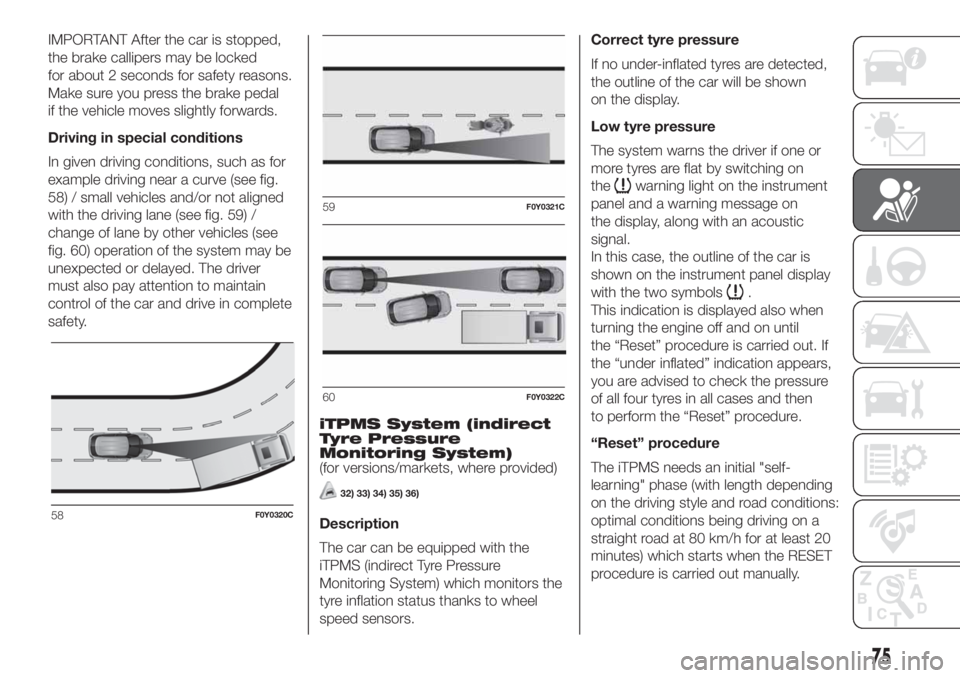
IMPORTANT After the car is stopped,
the brake callipers may be locked
for about 2 seconds for safety reasons.
Make sure you press the brake pedal
if the vehicle moves slightly forwards.
Driving in special conditions
In given driving conditions, such as for
example driving near a curve (see fig.
58) / small vehicles and/or not aligned
with the driving lane (see fig. 59) /
change of lane by other vehicles (see
fig. 60) operation of the system may be
unexpected or delayed. The driver
must also pay attention to maintain
control of the car and drive in complete
safety.
iTPMS System (indirect
Tyre Pressure
Monitoring System)
(for versions/markets, where provided)
32) 33) 34) 35) 36)
Description
The car can be equipped with the
iTPMS (indirect Tyre Pressure
Monitoring System) which monitors the
tyre inflation status thanks to wheel
speed sensors.Correct tyre pressure
If no under-inflated tyres are detected,
the outline of the car will be shown
on the display.
Low tyre pressure
The system warns the driver if one or
more tyres are flat by switching on
the
warning light on the instrument
panel and a warning message on
the display, along with an acoustic
signal.
In this case, the outline of the car is
shown on the instrument panel display
with the two symbols
.
This indication is displayed also when
turning the engine off and on until
the “Reset” procedure is carried out. If
the “under inflated” indication appears,
you are advised to check the pressure
of all four tyres in all cases and then
to perform the “Reset” procedure.
“Reset” procedure
The iTPMS needs an initial "self-
learning" phase (with length depending
on the driving style and road conditions:
optimal conditions being driving on a
straight road at 80 km/h for at least 20
minutes) which starts when the RESET
procedure is carried out manually.
58F0Y0320C
59F0Y0321C
60F0Y0322C
75
Page 78 of 248
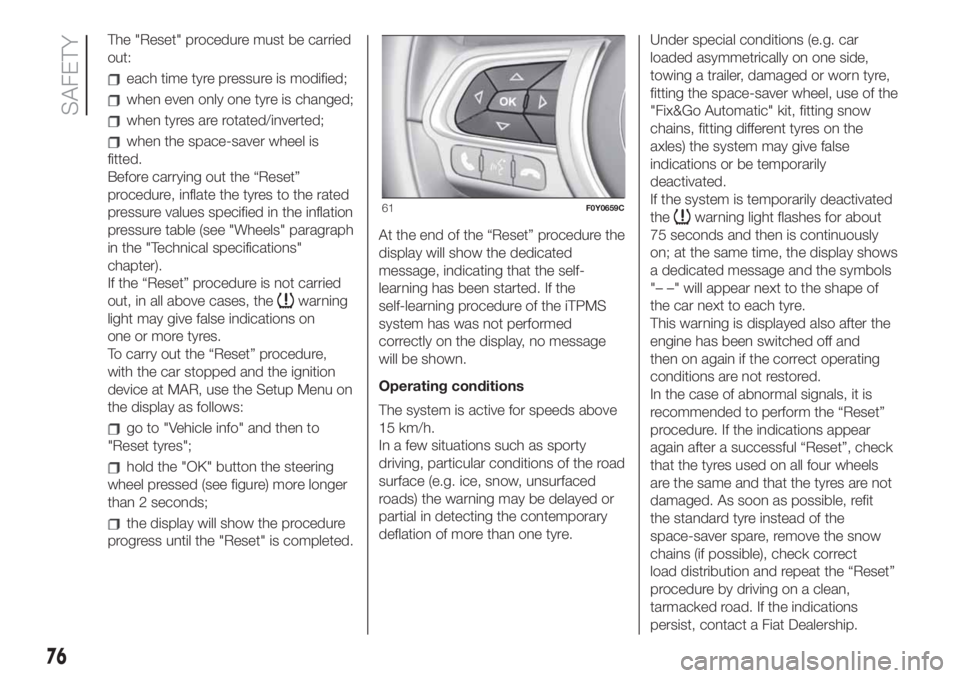
The "Reset" procedure must be carried
out:
each time tyre pressure is modified;
when even only one tyre is changed;
when tyres are rotated/inverted;
when the space-saver wheel is
fitted.
Before carrying out the “Reset”
procedure, inflate the tyres to the rated
pressure values specified in the inflation
pressure table (see "Wheels" paragraph
in the "Technical specifications"
chapter).
If the “Reset” procedure is not carried
out, in all above cases, the
warning
light may give false indications on
one or more tyres.
To carry out the “Reset” procedure,
with the car stopped and the ignition
device at MAR, use the Setup Menu on
the display as follows:
go to "Vehicle info" and then to
"Reset tyres";
hold the "OK" button the steering
wheel pressed (see figure) more longer
than 2 seconds;
the display will show the procedure
progress until the "Reset" is completed.At the end of the “Reset” procedure the
display will show the dedicated
message, indicating that the self-
learning has been started. If the
self-learning procedure of the iTPMS
system has was not performed
correctly on the display, no message
will be shown.
Operating conditions
The system is active for speeds above
15 km/h.
In a few situations such as sporty
driving, particular conditions of the road
surface (e.g. ice, snow, unsurfaced
roads) the warning may be delayed or
partial in detecting the contemporary
deflation of more than one tyre.Under special conditions (e.g. car
loaded asymmetrically on one side,
towing a trailer, damaged or worn tyre,
fitting the space-saver wheel, use of the
"Fix&Go Automatic" kit, fitting snow
chains, fitting different tyres on the
axles) the system may give false
indications or be temporarily
deactivated.
If the system is temporarily deactivated
the
warning light flashes for about
75 seconds and then is continuously
on; at the same time, the display shows
a dedicated message and the symbols
"– –" will appear next to the shape of
the car next to each tyre.
This warning is displayed also after the
engine has been switched off and
then on again if the correct operating
conditions are not restored.
In the case of abnormal signals, it is
recommended to perform the “Reset”
procedure. If the indications appear
again after a successful “Reset”, check
that the tyres used on all four wheels
are the same and that the tyres are not
damaged. As soon as possible, refit
the standard tyre instead of the
space-saver spare, remove the snow
chains (if possible), check correct
load distribution and repeat the “Reset”
procedure by driving on a clean,
tarmacked road. If the indications
persist, contact a Fiat Dealership.61F0Y0659C
76
SAFETY